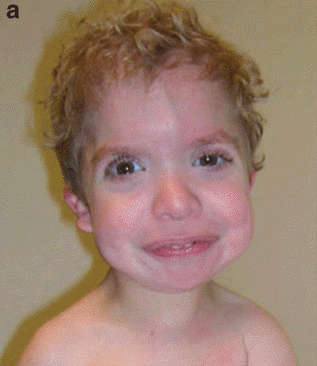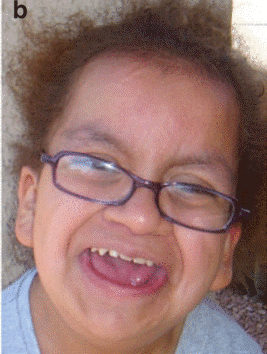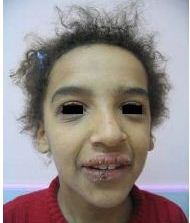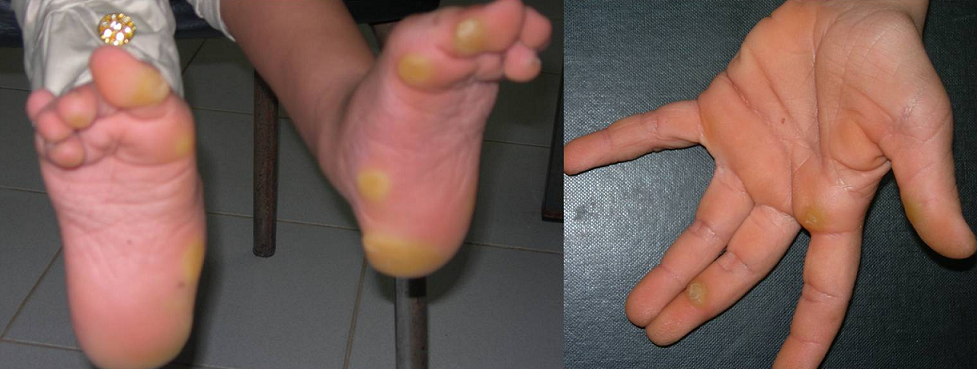Costello syndrome
Costello syndrome is a member of a group of conditions called RASopathies. RASopathies often affect growth and development. They share a number of other clinical features include common facial appearances, heart problems, neurlogical problems, and problems with the gastrointestinal tract. Individual RASopathies are rare, but as a group, they are common.
RASopathies are caused by mutations in genes that have roles in a pathway called Ras-MAPK. A pathway is a series of actions that occur in a cell. The actions lead to changes, like cell division or to something being made (a scab or new fat cells) or released (insulin). In some ways, pathways are like Rube Goldberg machines, because one molecule interacts with another one, which causes something else to happen, and so on. Pathways allow different body systems to work with each other. They are found in all processes in living things. Not surprisingly, when one or more pathways do not function properly, medical problems can result.
In the Ras-MAPK pathway, proteins communicate signals from outside a cell to the DNA inside the cell's nucleus. One result is a signal telling the cell to duplicate its DNA and then divide into two cells. If the Ras-MAPK pathway isn't functioning properly, cell division can be affected, such as by being overactive. When cells divide too frequently, tumors and cancer can result. As an example, people with Costello syndrome have an increased risk for a type of cancer called rhabodmyosarcoma, which tends to form in muscles that attach to bones (1, 2). Other forms of cancer associated with Costello syndrome include neuroblastoma, which is a cancer that develops in nerve tissue formed very early in development (before birth). Tumors are often found in hormone-producing glands above the kidneys (adrenal glands) or near the spine. According to one review, the lifetime cancer risk for people with Costello syndrome is 15% (2).
Other RASopathies include Noonan syndrome, Noonan syndrome with multiple lentigines (formally LEOPARD syndrome), neurofibromatosis type 1, cardio-facio-cutaneous (CFC) syndrome, and Legius syndrome.
Clinical information
Costello syndrome affects many body systems, and patients typically have intellectual disability and loose skin. Roughly two-thirds of people with Costello syndrome also have heart problems (see list below), and close to half have benign/non-cancerous tumors, including papillomas. Papillomas resemble warts (though they are brownish in color) and often located under the nose in Costello patients. Common features of this syndrome include the following:
- Intellectual disability
- Macrocephaly (large head)
- Brain atrophy/ventriculomegaly
- Short stature
- Feeding difficulties
- Failure to thrive
- Deep palmar creases
- Hoarse voices
- Loose skin, especially on the hands/feet
- Hyperkeratosis (thickened skin; see photos below)
- Lax/loose joints
- Broad fingertips
- Nail dystrophy/dysplasia
- Hernias
- Nasal papllilomata (aka papillomas)
Facial features in Costello syndrome
In addition, people with this syndrome have a distinctive appearance (see photos) that includes the following:
- Large mouth
- Large tongue
- Thick lips
- Large forehead
- Epicanthal folds (inner eyelids)
- Thick eyebrows
- Short or bulbous nose
- Low set ears
- Large or fleshy earlobes
- Curly hair (some patients have straight hair)
- Short neck
Facial features in Costello syndrome
Diagnosis and testing
Costello syndrome is an autosomal dominant disorder. This term means that only one copy of a mutated gene is needed to cause the disorder. Many autosomal dominant disorders are inherited from a parent who has the disease. Others occur when a mutation arises spontaneously. Costello syndrome generally results from spontaneous mutations in a gene called HRAS. Because the mutations occur spontaneously, parents are unlikely (though not completely impossible) to have a second child with this syndrome. Researchers do not know why the mutation arises.
A diagnosis of Costello syndrome is suspected based on clinical findings, including those listed on this page. The diagnosis can be confirmed by testing for mutations in the gene HRAS. There are many labs around the world that do this test. The US National Institutes of Health maintains a list of them (see link at right). If you suspect that your child has Costello syndrome, check with your family physician, who will compare your child's signs and symptoms with those known to occur in Costello syndrome. If your child's doctor isn't familiar with Costello syndrome, the information from Costello Kids may help. Your doctor can obtain a sample from your child and send it to a testing center.
Differential diagnosis
Noonan syndrome (NS) and cardiofaciocutaneous syndrome (CFC syndrome). Both of these conditions are also rasopathies. Distinguishing them from Costello syndrome may not be easy in young children, but the differences between the three syndromes become more obvious as children age. Very young Noonan syndrome patients may have excess skin around their necks, giving them a similarity with Costello patients, who also have loose skin. Girls with Turner syndrome also have this trait. In addition, NS patients can have congenital cardiac problems and short stature. Intelligence is normal in more than half people with NS, with some patients having mild intellectual disabilities.
One method for distinguishing Costello syndrome from both CFC and Noonan syndromes in very young patients appears to be examine the skin on the the hands and feet. In Costello syndrome, the skin is loose. In Noonan and CFC syndromes, it is not (1). Costello syndrome patients tend to have thick, full eyebrows, while eyebrows are sparse in CFC syndrome (1). Papillomas around the nose are also distinctive in Costello syndrome (1).
According to NIH's GeneReviews (2), Noonan syndrome is marked by distinctive chest deformities (pectus carinatum/pigeon chest combined with pectus excavatum/sunken chest). In NS patients, the upper chest is marked by an outward pigeon-chest shape, while the lower chest is marked by a sunken appearance. Although both pectus excavatum and carinatum occur in Costello syndrome patients, the combination of both of them together appears to be distinctive to NS. In addition, people papillomata, which are small wart-like growths. In Costello patients, they tend to grow under or near the nose. These growths may not be present in very young children, but when they occur in combination with other problems associated with Costello syndrome, they are a strong indicator of this condition.
Noonan syndrome is caused by mutations in PTPN11, SOS1, RAF1, KRAS, and NRAS. It may also be caused by mutations in the genes BRAF and MEK in a very small minority of patients (<2%). Importantly, mutations in the gene HRAS cause Costello syndrome and do not cause Noonan syndrome. Thus, genetic testing can distinguish these two condtions.
CFC syndrome patients have intellectual disabilities, growth impairment, and feeding difficulties like Costello syndrome patients. They also have cardiac abnormalities that resemble those seen in Costello syndrome. However, two differences between these conditoins are that CFC syndrome patients do not have thick lips and their eyebrows tend to be sparse or absent (2). Nasal papillomata do not occur in CFC syndrome, though again, these entities may also not be present in very young patients with Costello syndrome. Mutations in HRAS are not associated with CFC syndrome, and genetic testing may be able to provide a definitive diagnosis. CFC syndrome is caused by mutations in BRAF, KRAS, MAP2K2, and MAP2K1.
Williams syndrome (WS). Costello syndrome can look similar to WS, in that patients with both conditions have lax joints, soft skin, intellectual disabilities, and short stature. However, WS patients have distinctive personality characteristics that can distinguish them from Costello syndrome patients. In particular, WS patients tend to be loquacious/very talkative, and often have a love of music and a talent for singing/remembering lyrics (even in other languages).
Other conditions in the differential diagnosis for Costello syndrome include Simpson-Golabi-Behmel syndrome and Beckwith-Wiedemann syndrome. For more information, see reference 2.
A study published in 2012 obtained growth data on 94 individuals with Costello syndrome (3). The authors obtained ~1,400 individual measurements of height, weight, and head circumference from birth to age 10. Due to the limited number of study subjects, they created curves for boys and girls combined. The weight and height curves go to age 10. The head circumference curves go to age 3. Head circumference data was limited after age 3, and making curves was not possible. The curves are available at the publisher's website.
References
- 1. Siegel MS et al. (2012) Dermatological Phenotype in Costello syndrome: consequences of Ras dysregulation in development. Br J Dermatol 166(3):601-607. Full text on PubMed.
- 2. Gripp KW & Lin AE (2006) Costello Syndrome. Updated January 12 2012,. In: Pagon RA, et al., editors. GeneReviews [Internet]. Seattle (WA): University of Washington, Seattle; 1993-2021. Full text.
- 3. Sammon MS et al. (2012) Normative growth charts for individuals with Costello syndrome. Am J Med Genet A 158A:2692-2699. Full text from publisher.
- 4. Aytekin S et al. (2012) Two new cases with Costello syndrome. Dermatol Online J 19(8):601-607. Full text from publisher.
- 5. Tajir M et al. (2012) Syndrome de Costello: à propos d'une observation. Pan African Med J 12:64. Full text on PubMed.
- 6. Madhukara J et al. (2007) Case report. Costello syndrome. Ind J Derm Ven Lepr 73(6):406-408. Full text from publisher.
- 7. Gripp AW & Lin AE (2012) Costello syndrome: a Ras/mitogen activated protein kinase pathway syndrome (rasopathy) resulting from HRAS germline mutations. Gen Med 14:285-292. Full text from publisher.





